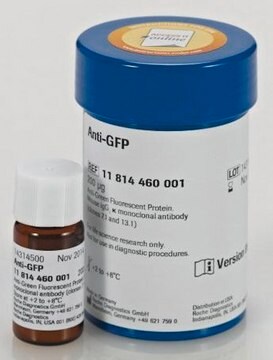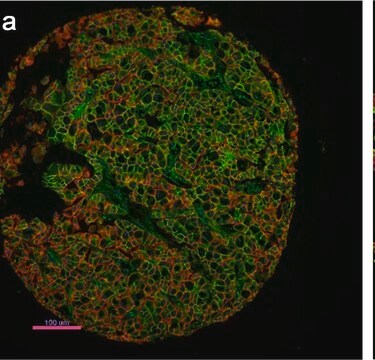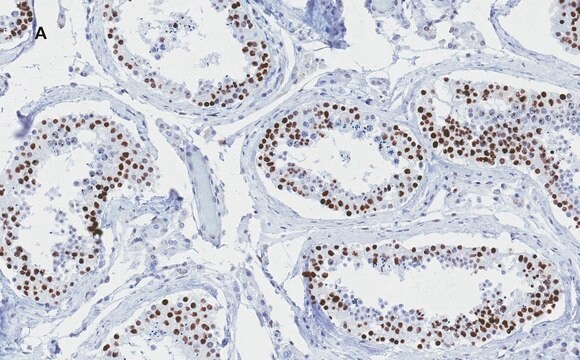一般說明
We are committed to bringing you greener alternative products, which adhere to one or more of The 12 Principles of Green Chemistry.This antibody is Preservative-free, produced without the harm or sacrifice of animals and exceptionally stable to allow for ambient shipping and storage if needed and thus aligns with "Waste Prevention", "Designing Safer Chemicals" and "Design for Energy Efficiency".
Click here for more information.
ZooMAb® antibodies represent an entirely new generation of recombinant monoclonal antibodies.Each ZooMAb® antibody is manufactured using our proprietary recombinant expression system, purified to homogeneity, and precisely dispensed to produce robust and highly reproducible lot-to-lot consistency. Only top-performing clones are released for use by researchers. Each antibody is validated for high specificity and affinity across multiple applications, including its most commonly used application. ZooMAb® antibodies are reliably available and ready to ship when you need them.
特異性
Clone 2I14 is a ZooMAb® Rabbit recombinant monoclonal antibody that specifically detects RNA-binding protein Musashi-1. It targets an epitope within 19 amino acids from the N-terminal region.
免疫原
KLH-conjugated linear peptide corresponding to 19 amino acids from the N-terminal region of human RNA-binding protein Musashi-1.
應用
Quality Control Testing
Evaluated by Western Blotting in SH-SY5Y cell lysate.
Western Blotting Analysis: A 1:1,000 dilution of this antibody detected Musashi- 1 in SH-SY5Y cell lysate.
Tested applications
Western Blotting Analysis: A 1:1,000 dilution from a representative lot detected Musashi-1 in Neuro2A cell lysate.
Immunohistochemistry (Paraffin) Analysis: A 1:100 dilution from a representative lot detected Musashi-1 in human small intestine tissue sections.
Affinity Binding Assay: A representative lot of this antibody bound Musashi-1 peptide with a KD of 6.0 x 10-6 in an affinity binding assay.
Flow Cytometry Analysis: 0.1 μg from a representative lot detected Musashi-1 in one million SH-SY5Y cells.
Note: Actual optimal working dilutions must be determined by end user as specimens, and experimental conditions may vary with the end user
Evaluated by Western Blotting in SH-SY5Y cell lysate.
Western Blotting Analysis: A 1:1,000 dilution of this antibody detected Musashi- 1 in SH-SY5Y cell lysate.
標靶描述
RNA-binding protein Musashi homolog 1 (UniProt: O43347; also known as Musashi-1) is encoded by the MSI1 gene (Gene ID: 4440) in human. Musashi-1 is a highly conserved RNA binding protein that regulates the expression of target mRNAs at the translation level. It contains two RNA recognition motifs (RRM1: aa 20-110 and RRM2: aa 109-186) and the first RRM binds more strongly to RNA compared to the second one. It binds RNA containing the sequence 5′-GUUAGUUAGUUAGUU-3′ and other sequences containing the pattern 5′-[GA]U1-3AGU-3′. Musashi-1 was first described in Drosophila where it was shown to block translation of Numb, a negative regulator of Notch 4 and Trk69. In mammalian system it is reported to maintain the proliferation of multipotential neural stem/progenitor cells, and it is rapidly downregulated in post-mitotic neurons. Its upregulation is reported in tumors originating from neural stem cells. It is over-expressed in glioblastoma (GBM) and serves as an unfavorable prognostic marker of GBM. It promotes cancer stem cell properties in GBM via upregulation of YTH N6-Methyladenosine RNA Binding Protein 1 (YTHDF1). Musashi-1-transduced mammary epithelial cells express CD24hi/Sca-1+ and CD24hi/CD29+ phenotypes that has been linked expansion of multipotent progenitor cells. Musashi-1-transduced cells are also shown to express a higher percentage of cytokeratin (CK) 6 and 19 and double-positive CK14/CK18 cells that are a mixture of stem and progenitor cells. Musashi-1 is detected in fetal kidney, brain, liver, and lung, and in adult brain and pancreas. This ZooMAbZooMAb® recombinant monoclonal antibody, generated by our propriety technology, offers significantly enhanced specificity, affinity, reproducibility, and stability over conventional monoclonals. (Ref.: Yarmishyn, AA., et al. (2020). Cancer Cell International volume 20; Article number: 597; Glazer, RI., et al. (2008). Cell Cycle. 7(17); 2635-2639).
外觀
Purified recombinant rabbit monoclonal antibody IgG, lyophilized in PBS, 5% Trehalose, normal appearance a coarse or translucent resin. The PBS/trehalose components in the ZooMAb formulation can have the appearance of a semi-solid (bead like gel) after lyophilization. This is a normal phenomenon. Please follow the recommended reconstitution procedure in the data sheet to dissolve the semi-solid, bead-like, gel-appearing material. The resulting antibody solution is completely stable and functional as proven by full functional testing. Contains no biocide or preservatives, such as azide, or any animal by-products. Larger pack sizes provided as multiples of 25 μL.
重構
300 μg/mL after reconstitution at 25 μL per vial. Please refer to guidance on suggested starting dilutions and/or titers per application and sample type.
儲存和穩定性
Recommend storage of lyophilized product at 2-8°C; Before reconstitution, micro-centrifuge vials briefly to spin down material to bottom of the vial; Reconstitute each vial by adding 25 μL of filtered lab grade water or PBS; Reconstituted antibodies can be stored at 2-8°C, or -20°C for long term storage. Avoid repeated freeze-thaws.
法律資訊
ZooMAb is a registered trademark of Merck KGaA, Darmstadt, Germany
免責聲明
Unless otherwise stated in our catalog or other company documentation accompanying the product(s), our products are intended for research use only and are not to be used for any other purpose, which includes but is not limited to, unauthorized commercial uses, in vitro diagnostic uses, ex vivo or in vivo therapeutic uses or any type of consumption or application to humans or animals.









